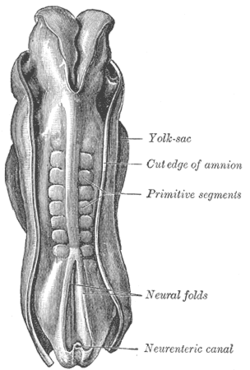Somites
| Somite | |
|---|---|

Transverse section of half of a chick embryo of forty-five hours' incubation. The dorsal (back) surface of the embryo is towards the top of this page, while the ventral (front) surface is towards the bottom.
|
|

Dorsum of human embryo, 2.11 mm in length. (The older term primitive segments is used to identify the somites.)
|
|
| Details | |
| Carnegie stage | 9 |
| Days | 20 |
| Precursor | paraxial mesoderm |
| Gives rise to | dermatome, myotome, sclerotome |
| Identifiers | |
| Latin | somitus |
| MeSH | A16.254.425.660.750 |
| Code | TE E5.0.2.2.2.0.3 |
|
Anatomical terminology
[]
|
|
A somite is a division of the body of an animal or embryo.
Somites are bilaterally paired blocks of paraxial mesoderm that form along the head-to-tail axis of the developing embryo in segmented animals. In vertebrates, somites subdivide into the sclerotomes, myotomes and dermatomes that give rise to the vertebrae of the vertebral column, rib cage, and part of the occipital bone; skeletal muscle, cartilage, tendons, and skin (of the back).
The word somite is also used in place of the word metamere. In this definition, the somite is a homologously paired structure in an animal body plan, such as is visible in annelids and arthropods.
The mesoderm forms at the same time as the other two germ layers, the ectoderm and endoderm. The mesoderm at either side of the neural tube is called paraxial mesoderm. It is distinct from the mesoderm underneath the neural tube which is called the chordamesoderm that becomes the notochord. The paraxial mesoderm is initially called the “segmental plate” in the chick embryo or the “unsegmented mesoderm” in other vertebrates. As the primitive streak regresses and neural folds gather (to eventually become the neural tube), the paraxial mesoderm separates into blocks called somites.
The pre-somitic mesoderm commits to the somitic fate before mesoderm becomes capable of forming somites. The cells within each somite are specified based on their location within the somite. Additionally, they retain the ability to become any kind of somite-derived structure until relatively late in the process of somitogenesis.
...
Wikipedia
